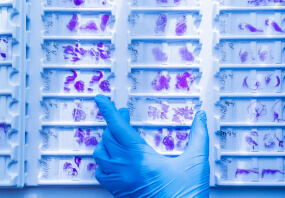General description
Akt is the major known effector of the PI3 Kinase pathway. Generation of PIP3 results in the activation of PDK1, which phosphorylates Akt on Thr308, and another kinase complex, thought to be the mTORC2 complex (or possibly an intermediate kinase linking the two) that phosphorylates Akt on Ser473. These phosphorylations additively activate Akt Ser/Thr kinase activity, and the use of phosphorylation state-specific antibodies directed against either of these sites can imply Akt activation. Activation of Akt can be measured directly by immunoprecipitation followed by phosphorylation of a known substrate with radiolabeled ATP. Akt has been shown to phosphorylate over 70 substrates including TSC1&2 in the mTOR pathway, Bad on Ser136, GSK3, which is inactivated by this phosphorylation, the FoxO family of transcription factors, PRAS40, AS160.
Specificity
Recognizes Akt1/PKBα, MW ~60 kDa.
Immunogen
15 residue synthetic peptide (C-RPHFPQFS YSASGTA) corresponding to the C-terminal (residues 466-480) of rat Akt1, with an N-terminal cysteine added for conjugation purposes. The Akt1 sequence is identical to mouse Akt1 (15/15 amino acids) and strongly conserved in bovine Akt1 (14/15 amino acids) and human Akt1 (13/15 amino acids). Human Akt2 shares 11/15 amino acids with the peptide immunogen sequence.
Epitope: C-terminus
Application
Immunoprecipitation Kinase Assay:
4 µg of a previous lot immunoprecipitated active Akt from 1 mg of HEK293 cells stimulated with IGF-1.
Research Category
Signaling
Research Sub Category
PI3K, Akt, & mTOR Signaling
This Anti-Akt1/PKBα Antibody is validated for use in IP, WB for the detection of Akt1/PKBα.
Quality
Evaluated by western blot in RIPA lysates from human A431 carcinoma cells.
Western Blot Analysis:
0.5-2 µg/mL of this antibody detected Akt in RIPA lysates from human A431 carcinoma cells.
Target description
~60 kDa
Physical form
Format: Purified
Protein A purified
Purified rabbit polyclonal in buffer containing 0.1 M Tris-glycine, pH 7.4, 0.15 M NaCl, 0.05% sodium azide before the addition of glycerol to 30%.
Storage and Stability
Stable for 1 year at -20ºC from date of receipt.
Analysis Note
Control
Positive Antigen Control: Catalog #12-301, non-stimulated A431 cell lysate. Add 2.5µL of 2-mercaptoethanol/100µL of lysate and boil for 5 minutes to reduce the preparation. Load 20µg of reduced lysate per lane for minigels.
Other Notes
Concentration: Please refer to the Certificate of Analysis for the lot-specific concentration.
Legal Information
UPSTATE is a registered trademark of Merck KGaA, Darmstadt, Germany
Disclaimer
Unless otherwise stated in our catalog or other company documentation accompanying the product(s), our products are intended for research use only and are not to be used for any other purpose, which includes but is not limited to, unauthorized commercial uses, in vitro diagnostic uses, ex vivo or in vivo therapeutic uses or any type of consumption or application to humans or animals.
- UPC:
- 51171628
- Condition:
- New
- Availability:
- 3-5 Days
- Weight:
- 1.00 Ounces
- HazmatClass:
- No
- MPN:
- 07-416-25UG












